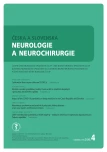Current diagnostics of secondary progressive form of multiple sclerosis and its treatment with siponimod
Authors:
P. Štourač
Authors‘ workplace:
Neurologická klinika LF MU a FN Brno
Published in:
Cesk Slov Neurol N 2020; 83/116(4): 364-367
Category:
Review Article
doi:
https://doi.org/10.14735/amcsnn2020364
Overview
Multiple sclerosis is a chronic inflammatory disease of the CNS. Secondary progressive MS is the second most common form of MS worldwide and symptomatic treatment is currently the only available option in the Czech Republic. Neurodegeneration and less inflammatory processes are the main pathophysiological processes underlying the transition to the secondary progressive phase of MS. Because of clinical diagnostic obstacles, the diagnosis of secondary progressive MS is often postponed by 3 years. Diagnostic criteria based on the data from MSBase registry enable the elimination of this diagnostic gap. Siponimod is the first oral drug for the treatment of secondary progressive MS with clinical or MRI activity reducing the disability progression or selected MRI parameters. The efficacy and safety of siponimod were tested in the phase III clinical trial EXPAND. The most suitable criteria for treatment with siponimod and its safety profile including possibilities in the case of treatment failure are under scrutiny of the scientific neurological society in the Czech Republic.
Keywords:
diagnosis – treatment – secondary progressive multiple sclerosis – siponimod
Sources
1. Multiple Sclerosis International Federation (MSIF) Atlas of MS 2013. [online]. Available from URL: https: // www.msif.org/wp-content/uploads/2014//09/Atlas-of- MS.pdf.
2. Khurana V, Sharma H, Medin J et al. Estimated prevalence of diagnosed secondary progressive multiple sclerosis in the Americas and Europe: results from a systematic literature search. Neurology 2018; 90 (15 Suppl): P2.380.
3. Scalfari A, Neuhaus A, Daumner M et al. Onset of secondary progressive phase and long-term evolution of multiple sclerosis. J Neurol Neurosurg Psychiatry 2014; 85 (1): 67–75. doi: 10.1136/jnnp-2012-304333.
4. Cree BA, Gourraud PA, Oksenberg JR et al. Long- -term evolution of multiple sclerosis disability in the treatment era. Ann Neurol 2016; 80 (4): 499–510. doi: 10.1002/ana.24747.
5. Coret F, Perez-Miralles FC, Gascon F et al. Onset of secondary progressive multiple sclerosis is not influenced by current relapsing multiple sclerosis therapies. Mult Scler J Exp Transl Clin 2018; 4 (2): 2055217318783347. doi: 10.1177/2055217318783347.
6. Lorscheider J, Buzzard K, Jokubaitis et al. Defining secondary progressive multiple sclerosis. Brain J Neurol 2016; 139 (9): 2395–2405. doi: 10.1093/brain/aww173.
7. Katz Sand I, Krieger S, Faqrrell C et al. Diagnostic uncertainity during the transition to secondary progressive multiple sclerosis. Mult Scler 2014; 20 (12): 1654–1657. doi: 10.1177/1352458514521517.
8. Inojosa H, Proschmann U, Akgun K et al. A focus on secondary progressive multiple sclerosis (SPMS): challenges in diagnosis and definition. J Neurol 2019; [ahead of print]. doi: 10.1007/s00415-019-09489-5.
9. Goodman D, Anadani N, Gerwitz L. Siponimod in the treatment of multiple sclerosis. Expert Opin Investig Drugs 2019; 28 (15): 1051–1057. doi: 10.1080/13543784. 2019.1676725.
10. Brinkman V. FTY 20 (fingolimod) in multiple sclerosis: therapeutic effect in the immune and the central nervous system. Br J Pharmacol 2009; 158 (5): 1173–1182. doi: 10.1111/j.1476-5381.2009.00451.x.
11. Gentile A, Musella A, Bullita S et al. Siponimod (BAF 312) prevents synaptic neurodegeneration in experimetal multiple sclerosis. J Neuroinflammation 2016; 13 (1): 207. doi: 10.1186/s12974-016-0686-4.
12. Kappos L, Bar-Or A, Cree B, et al. Siponimod versus placebo in secondary progressive multiple sclerosis (EXPAND): a double-blind, randomised, phase 3 study. Lancet 2018; 391 (10127): 1263–1273. doi: 10.1016/S0140-6736 (18) 30475-6.
13. Mayzent. Souhrn údajů o přípravku. [online]. Dostupné z URL: https: //www.ema.europa.eu/en/documents/product-information/mayzent-epar-product-information_cs.pdf.
14. SÚKL. Státní ústav pro kontrolu léčiv. Gilenya – Souhrn údajů o přípravku. [online]. Dostupné z URL: http: //www.sukl.cz/modules/medication/detail.php?code=0168462&tab=texts.
Labels
Paediatric neurology Neurosurgery NeurologyArticle was published in
Czech and Slovak Neurology and Neurosurgery

2020 Issue 4
Most read in this issue
- It is evident when to make a surgery for lumbar disc herniation?
- CGRP monoclonal antibodies in the treatment of migraine – indication criteria and therapeutic recommendations for the Czech Republic
- Current diagnostics of secondary progressive form of multiple sclerosis and its treatment with siponimod
- Cytotoxic lesions of the corpus callosum (CLOCCs)
